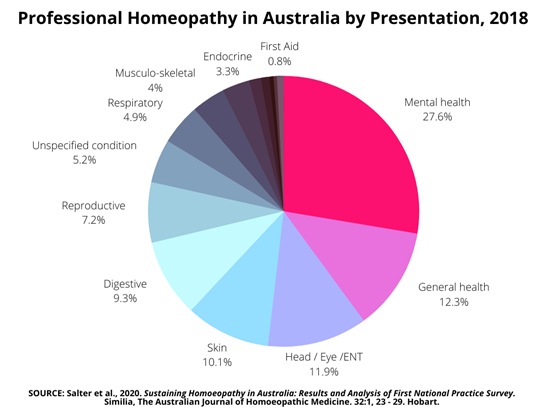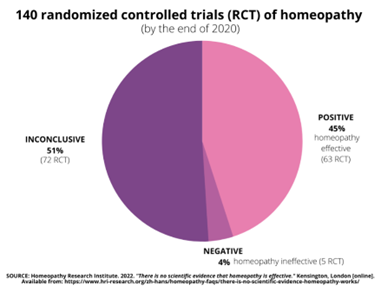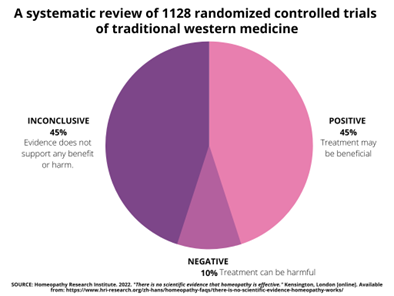It is estimated that 1.1 million Australians choose homeopathy (1)* which has been used in Australia since 1830 (2).
The Aurum Project, Australia’s peak body for homeopathy research, found that professional Australian homeopaths (registered with the Australian Register of Homoeopaths [ARoH]) are working with people of all ages - from the newborn to advanced age - for a wide range of health issues, the most common being mental health (3) (Fig.1), which is also the main reason for a visit to the GP in Australia (4).

Figure 1: Professional homeopathy in Australia by Presentation, 2018. (3)
As of 2020, there were 233 randomized controlled trials (RCT) of homeopathic treatment for 129 medical conditions. 140 are peer-reviewed, placebo-controlled and double-blinded, covering 86 medical conditions. 63 concluded homeopathy is effective, 5 found homeopathy ineffective, and 72 were inconclusive (Fig. 2). Data from 1128 traditional Western medicine RCTs show similarities (5) (Fig. 3).

Figure 2: Homeopathy placebo-controlled trial data, 2020 (5).

Figure 3: Systematic review Western medicine RCT data, 2020 (5).
Homeopathic research is conducted in highly regarded hospitals, research institutes and universities worldwide, with researchers applying the same techniques as their peers who study traditional Western medicine (5).
In 2018 the global homeopathic product market was valued at US$5.6 Billion, which is projected to expand to US$18.6 Billion by the end of 2027 (6). Homeopathy has been shown to improve quality of life (7,8,9) highlighting the pressing need for more research.
Almost eleven million Australians use complementary medicine**(1), however, just 0.14% of the national medical research budget was allocated to complementary medicine (CM) in 2012 (10) despite Australia having some of the highest rates of CM utilization in the developed world (11).
The Australian National Health and Medical Research Council (NHMRC) Information Paper on homeopathy published in 2015 (commonly referred to as the Australian Review) concluded that there are no health conditions for which there is reliable evidence that homeopathy is effective. But in 2019, after untold damage to homeopathy worldwide, their CEO stated that 'contrary to some claims the review did not conclude that homeopathy was ineffective' (12).
Containing numerous instances of serious procedural and scientific misconduct, the Australian Review was the NHMRC’s second attempt ... Interestingly, the first Review of 2012 which found encouraging evidence for the effectiveness of homeopathy in five medical conditions remained undisclosed until its existence was uncovered in 2019, when the resultant and sustained international outcry ensured its release (13).
The NHMRC Australian Review stakeholder complaint (14), lodged in 2016, remains before the Commonwealth Ombudsman.
References:
(1) Steel, A., McIntyre, E., Harnett, J., Foley, H., Adams, J., Sibbritt, D., Wardle, J., & Frawley, J. 2018. Complementary medicine use in the Australian population: Results of a nationally-representative cross-sectional survey. Scientificreports [online]. 8 (1), 17325. Available from https://www.ncbi.nlm.nih.gov/pmc/articles/PMC6251890/
* Steel et al. (2018) found prevalence of 6.8% using homeopathy. The 2016 Australian population was 23.4 million, with 17.3 million (74.2%) aged over 20 years. (Australian Bureau of Statistics. 2020. Canberra [online]. Available from: https://quickstats.censusdata.abs.gov.au/census_services/getproduct/census/2016/quickstat/UCL513003)
** Steel et al. (2018) found prevalence of any Australian CM use to be 63.1%. The 2016 Australian population was 23.4 million, with 17.3 million (74.2%) aged over 20 years (2)
(2) Armstrong, B. 2022. History of Homeopathy in Australia. History of Homeopathy. Australia [online]. Available from: https://historyofhomeopathy.au/timeline.html
(3) Salter, CJ., Brodie, G., Jordan, L., Mattiolo, L., Manning, A., Bhouraskar, S., Levy, D. 2020. Sustaining homeopathy in Australia: Results and Analysis of First Practice Survey. Similia, The Australian Journal of Homeopathic Medicine. 32:1, 23-29. Hobart. The Australian Homeopathic Association
(4) The Royal Australian College of General Practitioners, 2022. RACGP, General Practice: Health of the Nation 2021 (Online) Available from: https://www.racgp.org.au/health-of-the-nation/chapter-1-current-and-emerging-issues/1-1-common-health-presentations-in-general-practic#Figure1
(5) Homeopathy Research Institute, 2022. Placebo controlled trial data update (online) Available from: https://www.hri-research.org/2021/10/2020-placebo-controlled-trial-data-update/
(6) Transparency Market Research. 2020. Homeopathic Product Market – Global Industry Analysis, Size, Share, Growth, Trends, and Forecast 2019-2027. Pune [online]. Available from: https://www.transparencymarketresearch.com/homeopathy-product-market.html
(7) Frass M, Lechleitner P, Gründling C, Pirker C, Grasmuk-Siegl E, Domayer J, Hochmair M, Gaertner K, Duscheck C, Muchitsch I, Marosi C, Schumacher M, Zöchbauer-Müller S, Manchanda RK, Schrott A, Burghuber O. 2020.Homeopathic Treatment as an Add-On Therapy May Improve QOL and Prolong Survival in Patients with Non-Small Cell Lung Cancer: A Prospective, Randomized, Placebo-Controlled, Double-Blind, Three-Arm, Multicenter Study. Oncologist [online]. Dec;25(12):e1930-e1955. Available from https://pubmed.ncbi.nlm.nih.gov/33010094/
(8) Witt CM, Lüdtke R, Mengler N, Willich SN. 2008. How healthy are chronically ill patients after eight years of homeopathic treatment?--Results from a long term observational study. BMC Public Health [online]. Dec 17;8:413. Available from https://www.ncbi.nlm.nih.gov/pmc/articles/PMC2630323/
(9) Bell IR, Lewis DA 2nd, Brooks AJ, Schwartz GE, Lewis SE, Walsh BT, Baldwin CM. 2004. Improved clinical status in fibromyalgia patients treated with individualized homeopathic remedies versus placebo. Rheumatology (Oxford)[online]. May;43(5):577-82. Available from https://pubmed.ncbi.nlm.nih.gov/14734789/
(10) Australian Homeopathic Association. 2017. The National Health & Medical Research Council (NHMRC) and Research Integrity. Hobart [online]. Available from http://www.nhmrchomeopathy.com/
(11) Andrews G, Adams J, Segrott J, Lui C. 2012. The Profile of Complementary and Alternative Medicine Users and Reasons for Complementary and Alternative Medicine Use. In: Adams J, Andrews G, Barnes J, Magin P, Broom A,editors. Traditional, Complementary and Integrative Medicine: An International Reader. London: Palgrave Macmillan; 2012. Available from https://www.researchgate.net/publication/259742121_The_profile_of_complementary_and_alternative_medicine_users_and_reasons_for_complementary_and_alternative_mediicne_use
(12) NHMRC. 2021. CEO statement. Release of an annotated version of the 2012 draft report The Effectiveness of Homeopathy: an overview review of secondary evidence. National Health and Medical Research Council. Australian Government Canberra [online]. Available from: https://www.nhmrc.gov.au/sites/default/files/documents/attachments/CEO-statement-signed.pdf
(13) Homeopathy Research Institute. 2021. The Australian Report. Kensington, London [online]. Available from https://www.hri-research.org/resources/homeopathy-the-debate/the-australian-report-on-homeopathy
(14) Australian Homeopathic Association. 2017. Executive Summary - Commonwealth Ombudsman Complaint. Hobart [online]. Available from http://www.nhmrchomeopathy.com/ombudsman-exec-summary.html
The structure of the homeopathic profession in Australia
There are a number of homeopathic associations in Australia, all of which are members of the Australian Register of Homoeopaths (ARoH). In order to become a professional member of any of these associations, practitioners have to meet the criteria for entry into ARoH.
ARoH provides a national body (structurally supported by the professional homeopathy associations) for determining standards for the education and competency of homeopaths. The Register acts as independently as possible from those associations, to uphold the standards and to receive and determine complaints.
Most of ARoH's member associations operate in different states, while the Australian Homoeopathic Association is the largest and only national association with Branches in 5 states. All member associations of ARoH have a Constitution, a Code of Ethics and a Complaints Procedure.


